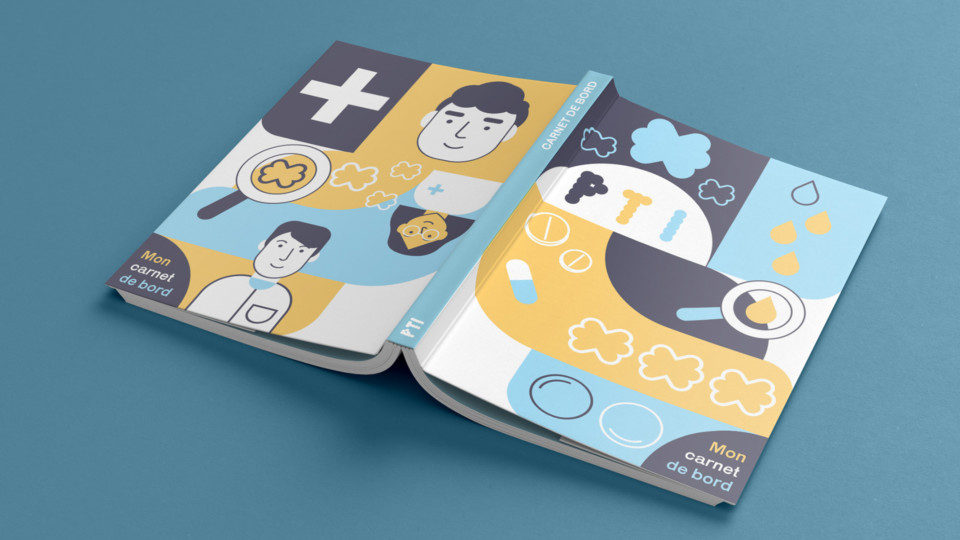Discovering an illness,
a notebook to support incoming patients with serious pathology
ethnographic phase – workshop facilitation – artistic direction – illustration and graphic design – mediation – information design
Discovering an illness,
a notebook to support incoming patients with serious pathology
Date
– 2021
Client
– AMGEN and patient association
Role
– ethnographic phase and interviews
– processing of interview data
– workshop facilitation with patients
– artistic direction
– illustration and graphic design
– mediation
– information design

The diagnosis of a chronic pathology is a strong point of tension for the patient: it is the moment of transition into a state of conscious fragility. A moment of rupture in life, the start of an « after », the emotions felt at this moment are often paradoxical: between relief at having to say a word about your ailments, and acute worry about the course to come. This is a special time for the majority of patients, where communicating clear information about the next steps would help to relieve the pressure. However, we note that the entry of a patient into pathology is often chaotic: no or little clear information, a mental load that does not allow them to record and take a step back on all the new information often communicated. orally, personal research on sites that are often alarmist, poorly informed, and incomplete, a feeling of being alone and of being subjected to it …
At the start of 2021, we were commissioned – a health consultant from Okoni, a medical editor, and myself – in this context, by a laboratory that was newly involved in the care of patients with new Purpura Thrombocytopenia Immunology. Immune Thrombocytopenic Purpura, called ITP, is a disease in which the body’s platelets are recognized as foreign by the immune system, and are destroyed primarily in the spleen organ. The brief? Design a booklet for newly diagnosed adult patients distributed during diagnosis, by healthcare professionals and patient associations.




To be as close as possible to the field and the issues encountered by newly diagnosed patients, we decided to involve patients in a co-design approach, thanks to patient associations. Who better than patients, who have lived this diagnosis and had experiences around the care pathway for this disease, would be better positioned to help new people?
We were, therefore, able to interview five volunteer patients – thanks to a call for participation launched by one of the patient associations – with different profiles, ages, regions, places of care, prior illness, and different backgrounds. To prepare for these interviews, we sent them a logbook beforehand, allowing them to remember the main stages of their care, to associate them with feelings and emotions. This allowed them to come back, at first alone, on their journey, to structure their remarks so as not to forget anything during our exchange.
Then we interviewed them individually during a semi-structured interview of about two hours. We then explored the different moments that they felt were important to share with us, from their medical wandering to their diagnosis, including the care and hospitalizations they had received. We were also able to discuss the impact of this disease and its management on their daily lives and their tips, by collecting their insights that best illustrated their different experiences.

Then, during a workshop to which they were all invited, we were able to develop together with the contents of this notebook to be created and the creative brief associated with the editorial object. Our goal: to reach as many people as possible and find in the specificity of each course the essential points to underline to help newcomers with this pathology.
Overall, we understand that this notebook should look like a GPS in their care path. It should help them become aware of the unpredictability of the disease while making them understand that they will be supported at each stage of care, by various health actors (specialists, general practitioners, pharmacists) who all have a role to play. The goal is also to offer them opportunities to help them create the most fluid itinerary possible to live better outside of these intense periods of care.
Regarding the notebook object, patients want a « welcome-pack » formula that supports readers in illness, assimilated as a first aid kit that creates proximity with its user. This means a user-friendly format, not too large, which makes it easier to read at home.
They all agree that the object is soft, understated, but comforting with soft and bright colors. They favor illustration over photographs and want to protect readers from overly violent images. Attached to this idea of temporality, they believe that the reader will need rigor at the time of the announcement and then more and more concrete and practical over the chapters.









Once the content is laid out, we print the first five prototypes and send them to the project participants. We meet a week later for a final workshop, to take into account their opinions and feedback on this prototype. Together, we scan all the pages, answer their questions and write down their comments on form and content to make the desired changes later.
At the end of July, the final files are validated and go to the printer. At the start of the school year, in September, more than 200 copies will be distributed to those who need it, to better understand the different stages to come and strengthen their confidence in the future and their knowledge of pathology they are starting hardly to consider.

